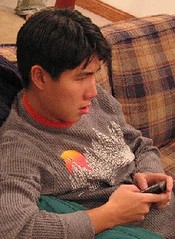Japan 2006: Shinjuku, Shibuya and Harajuku
Tokyo itself is somewhat of a monster. Like Los Angeles, it is made up of several 'downtowns' such as Shinjuku, Shibuya and Ropponggi. Ginza and Marounochi remain the main business and financial centers, though Shinjuku, with its ever changing skyline is fast catching up. These places are where shiny skyscrapers and ultra-modernist architecture gelled into a staid landscape of neon, steel (Japan is a major exporter of steel) and glass.
Ginza is also a shopping belt ala Fifth Avenue and Champs-Elysee with high-end fashion and couture boutiques. It has a Louis Vuitton store that is even bigger than the one in Paris to cater to the brand-whores that are Japanese.
But the larger shopping nexus are located at Shinjuku, Shibuya and Harajuku.
Shinjuku
Shinjuku, with its all-directional simultaneous pedestrain crossing, epitomizes the orderly chaos that I see in Japan. Here, large neon billboards battle with videotron screens to catch anyone and everyone's attention, while loud speakers and blaring music from the stores compete aggressively with the amateur rock bands on the streets.
At Kabuki-cho ward at Shinjuku, pachinko parlors, sex shops, love hotels (to cater to dating adults who continue to live in their parents' house with non-ideal acoustic proofing walls) and ramen noodle houses stand cheek by jowl on the pedestrianized streets. Menawhile, teenage "tribes", who are less like gangs but still as exclusive, fight for turf at the most popular spots.
Shibuya and Harajuku
Over at Shibuya, the Omotesando - a shopping boulevard, is less sleazy but equally ostentatious and high-end. Throngs of crowd meet outside the Shibuya station at the statue of Hachiko the dog. Hachiko is the famous dog who faithfully waited at the train station everyday for his deceased owner, a professor at the Imperial University, till his very own demise.
Immediately north and in great contrast to Shibuya is Harajuku, where small indie stores and second-hand goods dominate. This is also the setting for the Harajuku kids - teenagers, usually female, come dressed in outrageous costumes of goth, nurse suits and anime characters, to live out a fantasy away from the patriachal conservatism that is at home.




0 planning advice given:
Post a Comment
<< Home